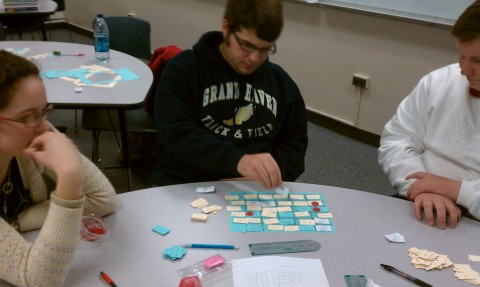Here’s a game I created last week called “Antiderivative Block” to encourage students to (1) learn their derivative rules well (2) begin thinking about derivatives backwards, and (3) to learn to be careful not to mix up derivatives and antiderivatives.

Here’s the game board of a well-played game:

The rules are very simple (they are described on the game pdf), but the game play is complex enough that you really have to be on your toes to play. Here are a couple of students demonstrating how to play:
I have to say that watching students play this game was the most fun I have ever had in a math class. They quickly got very competitive and I heard several students in both classes say something like “I really need to learn these derivatives” – even when you think you have won the game, it can be lost by missing a negative on an answer. Within 10-minutes, students from different pairs were challenging each other to matches (winners played winners). Some won on mathematical skill alone (being better at the derivatives than their opponent), some won by playing the game well (and knowing their math). Their attempts to psych each other out and cross-group banter had me laughing so hard in one class that I was crying.
Another interesting side effect of this game was that one of my ESL students suddenly got much better at correctly saying the math because his opponents wouldn’t let him claim spaces if he said “sine x squared” instead of “sine squared x” … I think his understanding of how to SAY the math had improved ten-fold by the end of the hour.
Don’t let the calculus nature of this game fool you. You could build the exact same game for learning trig values of special angles, for learning to simplify exponential expressions, for exponential and log functions. As a matter of fact, on the very same day I built this game, I instantly modified it for learning vocabulary in my MathET class (lucky for me, every student already had a set of small vocabulary cards that were the same size as the gameboard spaces). Here they are playing Geometry Vocabulary Block:

We also had one group of three players (we used red chips for the third player) and everyone who tried the 3-player game said that the gameplay was very different than the 2-player game. So a simple alteration to the game is just to change the number of players. The students also suggested that they wanted more cards to move into the game board so that the problems were always fresh.

P.S. Sorry about the strange RSS problem this week. It was not intentional. Just a misguided WordPress plugin that I tried. Needless to say, it has been disabled.




